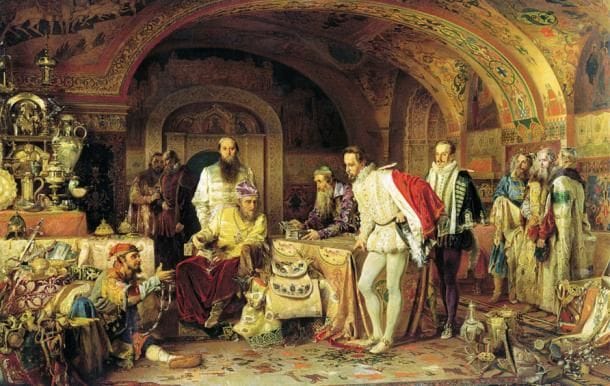In the shadowy depths of the Kremlin, whispers of a lost library echo through the ages. This is no ordinary collection of dusty tomes; it’s the fabled Library of Ivan the Terrible, a treasure trove of ancient knowledge said to hold secrets that could rewrite history. Join us as we embark on a quest to uncover the truth behind this legendary library, exploring its origins, its rumored contents, and the centuries-old search for its whereabouts.
Library of Ivan the Terrible: A Treasure Lost to Time
The legend of Ivan the Terrible’s lost library, sometimes referred to as the “Golden Library,” has captivated imaginations for centuries. Imagine a collection so vast and valuable, containing ancient texts and scrolls dating back to antiquity, that its discovery could reshape our understanding of the past. This is the allure of the library rumored to have been assembled by Grand Duke Ivan III and his son, the infamous Ivan IV, better known as “the Terrible.”
The story goes that this father-son duo were avid collectors of rare and important books, amassing a collection of unparalleled scope. They sought out texts from across the known world, from the great libraries of Byzantium to the distant lands of China. The library is believed to have contained a wealth of knowledge, including ancient Greek philosophy, Roman histories, and possibly even scrolls dating back to the Roman and Greek empires. Some believe that Ivan III’s wife, Sophia, a Byzantine princess, even contributed to the collection, bringing some of the books as part of her dowry.
The most enduring mystery surrounding the library is its location. While its existence is not definitively proven, many believe it lies hidden deep beneath the Kremlin in Moscow, concealed within secret vaults and protected by layers of history and legend. Some whisper of curses guarding the library, while others speculate about elaborate mechanisms designed to keep intruders at bay.
Over the centuries, the allure of the lost library has attracted numerous treasure seekers and historical figures, all eager to unlock its secrets. Peter the Great and Napoleon Bonaparte are just two of the notable figures who are said to have launched expeditions in search of the library, driven by a thirst for knowledge and the possibility of untold riches.
To this day, the library remains elusive. Did it ever exist? Was it lost to fire, flood, or the chaos of history? Or is it still out there, patiently waiting to be rediscovered? The mystery of Ivan the Terrible’s library continues to intrigue, reminding us that history is full of unanswered questions and that some secrets are buried deep.
For more captivating historical content, Check This Out.
What is the lost library of the Russian tsars?
The Lost Library of the Russian Tsars, often intertwined with the legend of Ivan the Terrible’s library, represents an even grander enigma. This isn’t simply a collection of old books; it’s envisioned as a repository of ancient wisdom, potentially containing scrolls and texts that predate the Roman and Greek empires. The library’s existence is shrouded in mystery, with its origins, contents, and location remaining subjects of ongoing debate and speculation.
Some historians suggest that the library’s foundations were laid by Grand Duke Ivan III in the 16th century. They point to accounts of Ivan III acquiring valuable Greek, Latin, and Egyptian works from the libraries of Constantinople and Alexandria, possibly as part of his wife Sophia’s dowry. Ivan IV, his son, is believed to have expanded upon this collection, acquiring texts from across Europe and Asia, including a significant number of Chinese manuscripts.
While the library’s exact location is unknown, many believe it to be hidden beneath the Kremlin in Moscow. This theory is fueled by historical accounts mentioning secret passages, hidden rooms, and vast underground chambers within the Kremlin complex. The possibility of stumbling upon such a treasure trove has captivated the imaginations of researchers, archaeologists, and treasure hunters for centuries.
The search for the Lost Library of the Russian Tsars has become intertwined with Russian history and culture. It has inspired countless stories, legends, and artistic works, reflecting the enduring fascination with uncovering lost knowledge and hidden treasures. Despite extensive searches and numerous claims of near discoveries, the library remains elusive.
Which king refused to save the Romanovs?
The tragic fate of the Romanovs during the Russian Revolution is a poignant reminder of the complexities of power, family ties, and political maneuvering. While several European monarchs considered offering refuge to Tsar Nicholas II and his family, the decision ultimately rested with King George V of England. As Tsar Nicholas II’s first cousin, King George V seemed like the obvious choice to provide asylum. However, he ultimately declined to offer them safe haven, a decision that continues to be debated by historians today.
Several factors influenced King George V’s decision. The British government, already deeply embroiled in World War I alongside Russia, feared that harboring the Romanovs could strain relations with the newly established Russian Provisional Government and potentially push Russia away from the Allied cause. Additionally, there were concerns about potential unrest within Britain itself, as anti-monarchist sentiments were on the rise.
Lord Stamfordham, a close advisor to King George V, played a significant role in shaping the king’s decision. He advised caution, highlighting the potential negative consequences of granting asylum to the Romanovs. Stamfordham argued that such a move could be perceived as an endorsement of the Tsar’s rule and might fuel anti-monarchist sentiment within Britain.
While King George V was not the only European monarch approached for help—King Christian of Denmark and King Alfonso XIII of Spain were also contacted—his refusal carried significant weight. The combination of political pressure, wartime anxieties, and fear of the burgeoning Bolshevik movement created a climate of hesitancy and inaction among European leaders.
The Romanovs’ story underscores the intricate interplay between global events and personal decisions. It serves as a stark reminder that even the strongest of family ties can be overshadowed by political realities and the pursuit of national interests. The refusal of King George V, whether driven by genuine concern for his country or a reluctance to become embroiled in another nation’s turmoil, remains a controversial chapter in history—one that continues to spark debate and speculation about what might have been.
Are there any tsars left?
The execution of Tsar Nicholas II and his family in 1918 marked the end of the Romanov dynasty and, with it, the end of tsarist rule in Russia. This begs the question: are there any tsars left? The straightforward answer is no. The execution of Nicholas II and his children effectively extinguished the direct line of succession. There is no one alive today who can lay claim to the title of Tsar of Russia based on direct lineage.
However, the Romanov family tree extends beyond the immediate line of succession. Several descendants of other members of the imperial family survived the revolution and fled Russia. These individuals, scattered across the globe, carry the Romanov bloodline and, to some extent, the legacy of their ancestors.
Among these descendants, Prince Rostislav Rostislavovich stands out as a prominent figure. A descendant of the Romanov family, he represents a continuation of the lineage, albeit one that is disconnected from any official claim to the throne. It’s important to note that in modern Russia, the prospect of a Romanov returning to a position of power is highly unlikely. The political landscape has changed drastically since the time of the tsars, and the idea of a monarchy is largely relegated to the history books.
What happened to Alexander the Great’s library?
The Great Library of Alexandria, often mistakenly attributed to Alexander the Great himself, was a beacon of knowledge in the ancient world. While its destruction is a significant loss, the common narrative surrounding it requires some clarification. Contrary to popular belief, the library’s destruction didn’t occur in a single catastrophic event. Instead, it faced a series of setbacks over several centuries, ultimately leading to its demise.
The library’s origins can be traced back to Ptolemy I Soter, one of Alexander the Great’s generals, who established a research institution known as the “Musaeum” in Alexandria, Egypt. Demetrius of Phalerum, a student of Aristotle, is credited with playing a crucial role in assembling the initial collection. It was under Ptolemy II Philadelphus, however, that the institution truly flourished. He established the “Royal Library,” which became the primary repository for manuscripts and scrolls.
Contrary to popular belief, the library was much more than a collection of scrolls. It was a bustling research institution, complete with lecture halls, laboratories, observatories, gardens, living quarters for scholars, and even a zoo. This unique environment fostered collaboration and intellectual exchange, making it a hub for scholars and thinkers from across the ancient world.
The first significant blow to the library came in 48 BC when Julius Caesar, embroiled in a conflict in Alexandria, accidentally started a fire that spread to the library. While the extent of the damage is debated, many scholars believe that the library likely recovered, either through reconstruction or because a portion of the collection survived.
The library faced subsequent challenges during Roman rule. In 270 AD, the Roman Emperor Aurelian sacked Alexandria, resulting in further damage to the library. Then, in 391 AD, the Christian bishop Theophilus ordered the destruction of pagan temples in Alexandria. This led to the destruction of the Serapeum, a temple complex that housed a significant portion of the library’s collection.
The final blow to the Library of Alexandria is often attributed to the Muslim conquest of Egypt in 642 CE. While accounts vary, it’s likely that the library had already suffered significant decline by this point, with much of its collection dispersed or destroyed.
While the loss of the Library of Alexandria is undeniably tragic, its impact on the trajectory of scientific progress is often overstated. Many important mathematical and physical works housed within the library were not unique to its collection and existed in other libraries. The destruction of the library, while a significant cultural loss, did not erase these advancements from history.
The legacy of the Library of Alexandria lies not just in the sheer volume of knowledge it once held but in its embodiment of a vibrant intellectual culture. It stands as a symbol of the pursuit of knowledge, the power of collaboration, and the fragility of even the most impressive repositories of human achievement.
What Was Lost in the Alexandria Library Fire?
The destruction of the Library of Alexandria, though a gradual process rather than a single catastrophic fire, represents an immeasurable loss for humanity. While the exact contents of the library remain unknown, its reputation as a repository for the accumulated knowledge of the ancient world suggests a staggering loss of literary, philosophical, and scientific works.
Imagine walking through the library’s grand halls before the fires. You might stumble upon original writings by Aristotle, whose ideas about logic, ethics, and politics laid the foundation for Western philosophy. Or perhaps you’d find yourself captivated by the dialogues of Plato, exploring timeless questions about justice, morality, and the nature of reality. The library likely housed a wealth of poetic works, including the lyrical verses of Sappho, whose writings explored themes of love, desire, and the human condition.
Beyond these iconic figures, the library served as a custodian for countless lesser-known works. Historians lament the loss of eyewitness accounts of epic battles, detailed records of ancient civilizations, and the whispered secrets of long-gone rulers. These lost texts could have provided invaluable insights into the lives, beliefs, and practices of past cultures, enriching our understanding of history and human development.
The library’s collection extended beyond the humanities. It likely housed pioneering medical texts containing detailed anatomical diagrams, groundbreaking theories about disease, and records of ancient surgical techniques. Imagine the medical advancements that could have been inspired by these lost works, potentially revolutionizing our understanding of the human body and the treatment of diseases.
The true extent of the loss remains a mystery, leaving us to speculate about the groundbreaking discoveries, the literary masterpieces, and the historical narratives that vanished in the flames. Some scholars believe that the library contained detailed astronomical charts, potentially surpassing our modern understanding of the cosmos. Others ponder the possibility of lost mathematical formulas, philosophical treatises that challenged conventional thinking, and scientific theories that could have reshaped our understanding of the natural world.
The destruction of the Library of Alexandria serves as a stark reminder of the fragility of knowledge. It underscores the importance of preserving and protecting our cultural heritage, ensuring that the knowledge and wisdom accumulated over centuries are not lost to the passage of time.
What Happened to the Romanovs’ Belongings?
The execution of the Romanovs in 1918 marked not only the end of a dynasty but also the beginning of a scramble for their vast wealth and possessions. The Bolsheviks, having seized control of Russia, wasted no time in confiscating the Romanovs’ belongings, which included a staggering collection of personal items, priceless art, and historical treasures.
Immediately following the family’s execution, Yakov Yurovsky, the chief executioner, oversaw the meticulous documentation and seizure of the Romanovs’ valuables. A list compiled by Yurovsky provides a glimpse into the opulence that once surrounded the family, detailing a collection that included gold watches, diamond jewelry, ornate tobacco cases, and a variety of personal trinkets. These belongings offer a poignant window into the Romanovs’ lives, showcasing their refined tastes, their personal connections, and the grandeur of their former status.
Among the confiscated items were personal trinkets engraved with inscriptions, revealing intimate details about family bonds and cherished memories. A trinket engraved with “Monplaisir 1830,” for example, hints at a shared history and a connection to a specific time and place. Portraits and brooches adorned with precious stones, once worn as symbols of power and prestige, now serve as poignant reminders of the human lives behind the imperial façade.
The Romanovs were known for their exquisite taste and their patronage of skilled artisans, a fact evident in the intricate craftsmanship of their belongings. Exquisite tobacco cases, crafted from gold, platinum, and enamel, exemplify this dedication to detail. These cases, often adorned with intricate designs and inscriptions commemorating significant occasions, such as the visit to Sebastopol in 1898, highlight the family’s appreciation for artistry and their connection to historical events.
While a significant portion of the Romanovs’ possessions was documented and transferred to state custody, the fate of many valuable items remains shrouded in mystery. The chaotic years following the revolution, coupled with the Bolsheviks’ need for funds, led to the sale of numerous Romanov treasures on the international market. As a result, countless pieces of the family’s history are now scattered across the globe, residing in private collections and museums, their provenance a subject of ongoing research and speculation.
The whereabouts of certain items, including valuable gemstones and objects of historical significance, remains unknown. Some may have been lost during the tumultuous events of the revolution, while others may have been secreted away, their locations lost to time. The search for these missing treasures continues, fueled by the allure of uncovering lost history and reclaiming pieces of a bygone era.
What happened to all the Romanov palaces?
The Russian Revolution of 1917 brought about a seismic shift in the nation’s social and political landscape. This transformation was not just ideological but deeply physical, extending even to the grand palaces that once symbolized the might and splendor of the Romanov dynasty. These opulent structures, scattered across the vast Russian landscape, were not simply abandoned or left to decay. Instead, they underwent a fascinating metamorphosis, reflecting the changing values and priorities of the newly established Soviet regime.
Some palaces, unfortunately, succumbed to the chaos of revolution, suffering damage or destruction during uprisings or battles. Their loss serves as a reminder of the often-turbulent nature of historical transitions. However, many others survived, their fates intertwined with the pragmatic needs and ideological leanings of the new government. These palaces, once symbols of imperial extravagance, were reimagined as practical spaces serving the needs of the people.
The Winter Palace in St. Petersburg, perhaps the most iconic of the Romanov residences, exemplifies this transformation. This sprawling palace, once the official residence of the Russian emperors, was repurposed as a military hospital during World War I. Following the revolution, it briefly housed the Museum of the Revolution before becoming the home of the State Hermitage Museum, one of the world’s largest and most renowned art museums. The palace’s grand halls, once reserved for imperial ceremonies and lavish balls, now echo with the footsteps of art enthusiasts from across the globe, their walls adorned with masterpieces from various cultures and eras.
Other palaces followed suit, their luxurious interiors repurposed to accommodate a range of functions. Some were transformed into government offices, their once opulent chambers now filled with desks and filing cabinets, the hum of bureaucracy replacing the hushed whispers of courtly intrigue. Others found new life as schools, their grand ballrooms transformed into classrooms where children from all walks of life could receive an education, a far cry from the exclusive world of their former occupants.
Even the palaces of the Grand Dukes, the extended family of the Tsar, were not spared from this repurposing. The Vladimir Palace, a masterpiece of Italianate architecture, became home to the House of Scientists, a testament to the new government’s emphasis on scientific advancement. Another palace, once owned by Grand Duchess Xenia Alexandrovna, was transformed into the Lesgaft University of Physical Education, its elegant halls now echoing with the sounds of athletic training and the pursuit of physical excellence.
Perhaps the most poignant transformation was that of the Anichkov Palace. Favored by Nicholas II, this palace, known for its elegant interiors and sprawling gardens, was transformed into the Palace of Pioneers after the revolution. This vibrant cultural center offered a wide range of activities for children, fostering creativity and learning in a space once associated with imperial privilege.
The repurposing of the Romanov palaces was not merely a matter of practicality but also a symbolic act. It reflected a conscious effort to transition from a culture of monarchy and exclusivity to one of public ownership and shared heritage. These palaces, once symbols of the divide between the ruling class and the populace, were now accessible to all, their grandeur repurposed to serve the needs and aspirations of the new Russia.
Tracing the lineage of these palaces, from their imperial origins to their present-day roles, offers a fascinating glimpse into the evolution of Russian society. Each palace tells a unique story, its walls whispering tales of grandeur, loss, adaptation, and renewal. As you explore these architectural marvels, take a moment to appreciate the layers of history embedded within their walls, each room a testament to the enduring power of human resilience and the ever-evolving narrative of a nation.
- Senior at What Age: Benefits & Eligibility Guide - March 29, 2025
- Unlocking Senior Benefits: How Old is a Senior? Your Complete Guide - March 29, 2025
- Master Russian Politeness:A Guide to Saying Please - March 29, 2025
















